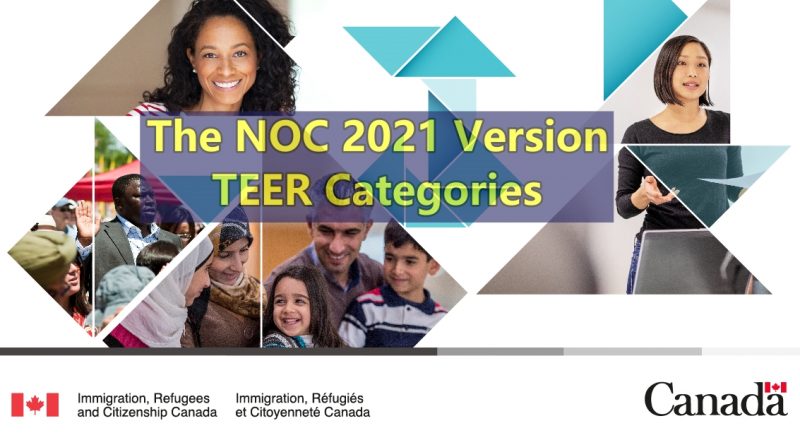Using The NOC 2021 Version TEER Categories (Training, Experience, Education and Responsibilities)
Distribution of NOC Unit Groups by Skill Level / TEER
| NOC 2016 V1.3 Distribution of Unit Groups by Skill Level | NOC 2021 V1.0 Distribution of Unit Groups by TEER | ||
|---|---|---|---|
| TEER Category 0 | 9% | ||
| Skill Level A | 28% | TEER Category 1 | 19% |
| Skill Level B | 42% | TEER Category 2 | 31% |
| Skill Level C | 24% | TEER Category 3 | 13% |
| Skill Level D | 6% | TEER Category 4 | 18% |
| TEER Category 5 | 9% | ||
The NOC 2021 Version 1.0 TEER Categories
The “TEER” categorization defines the requirements of the occupation by considering the type of training, education and experience required for entry, as well as the complexities and responsibilities typical of an occupation.
| The NOC 2021 TEER V1.0
Training, Education, Experience and Responsibility (TEER) |
when the second digit is… |
|---|---|
|
0 |
|
1 |
|
2 |
|
3 |
|
4 |
|
5 |
The Standard NOC 2021 Version 1.0 classification structure
The standard classification structure uses a five-tiered hierarchical arrangement of occupational groups with successive levels of disaggregation and contains broad, major, sub-major, minor and unit groupings. The structure of the NOC 2021 Version 1.0 is based on two key occupational categorizations: Occupational categories and TEER categories, which are identified in the first two digits of the 5-digit code, as shown in the table below.
| Title of Hierarchy | Format | Digit | Represents: |
|---|---|---|---|
| Broad Category | X | First Digit – X | Occupational categorization |
| Major Group | XX | Second Digit xX | TEER categorization |
| Sub-major Group | XXX | xxX | Top level of the Sub-Major Group |
| Minor Group | XXXX | xxXX | Hierarchy within the Sub-Major Group |
| Unit Group | XXXXX | xxXXX | Hierarchy within the Minor Group |
Note: As the first digit identifies the Occupation and the second digit identifies the TEER, they are also referred to as the Major Group.
Nomenclature and number of categories within each level of NOC 2021 Version 1.0
| Level | Coding | Number of categories |
|---|---|---|
| Broad Category | 1-digit and first digit of all codes | 10 |
| TEER | Second-digit of all codes | 6 |
| Major Group | 2-digit representing the broad category code and the TEER code | 45 |
| Sub-major Group | 3-digit | 89 |
| Minor Group | 4-digit | 162 |
| Unit Group | 5-digit | 516 |
Broad categories
The Broad Category (first digit) of the classification represents the occupational categorization which is defined by the type of work performed, the field of study, or the industry of employment. There are 10 Broad categories in NOC 2021 Version 1.0.
TEER categories
The TEER Category (second digit) of the classification represents the necessary training, education, experience and responsibilities of the occupation. There are 6 TEER categories in NOC 2021 Version 1.0.
Major groups
The Major Group (first and second digits) of the classification is represented by the Broad occupational categorization (first digit) and TEER categorization (second digit) together. A major group also encompasses several sub-major groups and thus represents the two-digit code used by the NOC. There are 45 major groups in NOC 2021 Version 1.0.
Sub-major groups
The Sub-major Group (3-digit) of the classification represents the aggregation of several minor groups and thus represents the three-digit code used by the NOC. There are 89 sub-major groups in NOC 2021 Version 1.0.
Minor groups
The Minor Group (4-digit) of the classification represents the domain in which an occupation is carried out (occupational domain). It is an aggregation of several unit groups and thus represents the four-digit code used by the NOC. There are 162 minor groups in NOC 2021 Version 1.0.





